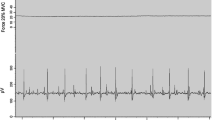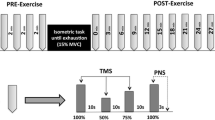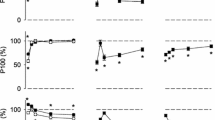Abstract
Our purpose was to study central fatigue and its dependence on peripheral reflex inhibition during a sustained submaximal contraction of the triceps surae. In 11 healthy subjects, superimposed twitches, surface electromyograms (EMG) from the medial head of the gastrocnemius (MG) and soleus (SOL) muscles, maximal compound motor action potentials (Mmax), tracking error and tremor were recorded during sustained fatiguing contractions at a torque level corresponding to 30% of maximal voluntary contraction (MVC). When the endurance limit (401±91 s) of the voluntary contraction (VC-I) was reached, the triceps surae could be electrically stimulated to the same torque level for an additional 1 min in 10 of the 11 subjects. These subjects were then able to continue the contraction voluntarily (voluntary contraction II, VC-II) for another 85±48 s. At the endurance limit of VC-I, the superimposed twitch was larger than during the unfatigued MVC, while there was no significant difference between the twitch at the endurance limit of VC-II and MVC. The EMG amplitude of both MG and SOL at the endurance limit of VC-I was significantly less than that during the MVC. While the EMG amplitude of MG increased further during VC-II, SOL EMG remained unchanged, neither muscle reaching their unfatigued MVC values. This difference was diminished for SOL by taking into account its decrease in Mmax found during VC-II, and relative EMG levels approached their MVC values. These results clearly indicate that a higher voluntary muscle activation was achievable after 1 min of electrical muscle stimulation, which continued metabolic stress and contractile fatigue processes but allowed for supraspinal, muscle spindle and/or motoneuronal recovery. It is concluded that peripheral reflex inhibition of α-motoneurons via small-diameter muscle afferents is of minor significance for the development of the central fatigue that was found to occur during the first voluntary contraction.
Similar content being viewed by others
References
Allum JHJ, Dietz V, Freund H-J (1978) Neural mechanisms underlying physiological tremor. J Neurophysiol 41:557–571
Belanger AY, McComas AJ (1981) Extent of motor unit activation during effort. J Appl Physiol 51:1131–1135
Bellemare F, Woods JJ, Johansson R, Bigland-Ritchie B (1983) Motor unit discharge rates in maximal voluntary contractions of three human muscles. J Neurophysiol 50:1380–1392
Bigland-Ritchie B, Cafarelli E, Vøllestad NK (1986) Fatigue of submaximal static contractions. Acta Physiol Scand 128:137–148
Bigland-Ritchie B, Dawson NJ, Johansson RS, Lippold OCJ (1986) Reflex origin for the slowing of motoneurone firing rates in fatigue of human voluntary contractions. J Physiol (Lond) 379:451–459
Bigland-Ritchie B, Furbush F, Woods JJ (1986) Fatigue of intermittent submaximal voluntary contractions: central and peripheral factors. J Appl Physiol 61:421–429
Binder MD, Heckman CJ, Powers RK (1993) How different afferent inputs control motoneuron discharge and the output of the motoneuron pool. Curr Opin Neurobiol 3:1028–1034
Bongiovanni LG, Hagbarth, K-E (1990) Tonic vibration reflexes elicited during fatigue from maximal voluntary contractions in man. J Physiol (Lond) 423:1–14
Brasil-Neto JP, Pascual-Leone A, Valls-Sole J, Cammarota A, Cohen LG, Hallett M (1993) Postexercise depression of motor evoked potentials: a measure of central nervous system fatigue. Exp Brain Res 93:181–184
Brasil-Neto J, Cohen LG, Hallett M (1994) Central fatigue as revealed by postexercise decrement of motor evoked potentials. Muscle Nerve 17:713–719
Cresswell AG, Löscher WN, Thorstensson A (1995) Influence of gastrocnemius muscle length on triceps surae torque development and electromyographic activity in man. Exp Brain Res 105:283–290
DeLuca CJ, Erim Z (1994) Common drive of motor units in regulation of muscle force. Trends Neurosci 17:292–304
Duchateau J, Hainaut K (1993) Behaviour of short and long latency reflexes in fatigued human muscles. J Physiol (Lond) 471:787–799
Edwards RG, Lippold OCJ (1956) The relation between force and integrated electric activity in fatigued muscle. J Physiol (Lond) 132:677–681
Fuglevand AJ, Zackowski KM, Huey KA, Enoka RM (1993) Impairment of neuromuscular propagation during human fatiguing contractions at submaximal forces. J Physiol (Lond) 460:549–572
Gallasch E, Löscher WN (1992) Characterisation of isometric tremor in the hand. Proceedings of 14th International Conference IEEE-BME, Paris, France, pp 1632–1633
Gallasch E, Kozlovskaya I, Löscher WN, Konev A, Kenner T (1994) Arm tremor and precision of hand force control in a short and long term flight on the MIR-space-station. Acta Astronaut 33:49–55
Gandevia SC (1992) Some central and peripheral factors affecting human motoneuronal output in neuromuscular fatigue. Sports Med 13:93–98
Gandevia SC, McKenzie DK (1988) Activation of human muscles at short muscle lengths during maximal static efforts. J Physiol (Lond) 407:599–613
Garland SJ (1991) The role of small diameter afferents in reflex inhibition during human muscle fatigue. J Physiol (Lond) 435:547–558
Garland SJ, McComas AJ (1990) Reflex inhibition of human soleus muscle during fatigue. J Physiol (Lond) 429:17–27
Garland SJ, Enoka RM, Serrano LP, Robinson GA (1994) Behavior of motor units in human biceps brachii during a submaximal fatiguing contraction. J Appl Physiol 76:2411–2419
Garnett R, Stephens JA (1981) Changes in the recruitment threshold of motor units produced by cutaneous stimulation in man. J Physiol (Lond) 311:463–473
Gottlieb S, Lippold OCJ (1983) The 4–6 Hz tremor during sustained contractions in normal human subjects. J Physiol (Lond) 336:499–509
Hagbarth K-E, Young RR (1979) Participation of the stretch reflex in human physiological tremor. J Physiol (Lond) 102:509–526
Kanda K, Burke RE, Walmsley B (1977) Differential control of fast and slow twitch motor units in the decerebrate cat. Exp Brain Res 29:57–74
Kernell D, Monster AW (1982) Motoneuron properties and motor fatigue. Exp Brain Res 46:197–204
Lännergren J, Westerblad H (1986) Force and membrane potential during and after fatiguing, continuous high-frequency stimulation of single Xenopus muscle fibres. Acta Physiol Scand 128:359–368
Lippold OCJ (1952) The relationship between integrated action potentials in a human muscle and its isometric tension. J Physiol (Lond) 117:492–499
Lippold OCJ (1970) Oscillations in the stretch reflex arc and the origin of the rhythmical 8–12 c/s component of physiological tremor. J Physiol (Lond) 206:359–382
Lloyd AR, Gandevia SC, Hales JP (1991) Muscle performance, voluntary activation, twitch properties and perceived effort in normal subjects and patients with the chronic fatigue syndrome. Brain 114:85–98
Logigan EL, Wierzbicka MM, Bruyninckx F, Wiegner AW, Shahahi BT, Young RR (1988) Motor unit synchronisation in physiological, enhanced physiologic, and voluntary tremor in man. Ann Neurol 23:242–250
Löscher WN, Gallasch E (1993) Myoelectric signal of two extrinsic hand muscles and isometric force tremor during sustained hand grip. Eur J Appl Physiol 67:99–105
Löscher WN, Cresswell AG, Thorstensson A (1994) Electromyographic responses of the human triceps surae and force tremor during sustained submaximal isometric plantar flexions. Acta Physiol Scand 152:73–82
Löscher WN, Cresswell AG, Thorstensson A (1995) Excitatory drive to the α-motoneuron pool during a fatiguing submaximal contraction in man. J Physiol (Lond) (in press)
Löscher WN, Cresswell AG, Ovendal A, Thorstensson A (1995) The influence of reduced Ia-afferent input on α-motoneuron pool excitability and tremor during sustained submaximal isometric plantar flexions. Proceedings of the Xth Congress of the International Society of Biomechanics, Jyväskylä, Finland. pp 572–573
Macefield G, Hagbarth K-E, Gorman R, Gandevia SC, Burke D (1991) Decline in spindle support to α-motoneurones during sustained voluntary contractions. J Physiol (Lond) 440:497–512
McKenzie DK, Bigland-Ritchie B, Gorman RB, Gandevia SC (1992) Central and peripheral fatigue of human diaphragm and limb muscles assessed by twitch interpolation. J Physiol (Lond) 454:643–656
Merton PA (1954). Voluntary strength and fatigue. J Physiol (Lond) 123:553–564
Rutherford OM, Jones DA, Newham DJ (1986) Clinical and experimental application of the percutaneous twitch superimposition technique for the study of human muscle activation. J Neurol Neurosurg Psychiatry 49:1288–91
Sandercock TG, Faulkner JA, Albers JW, Abbrecht PH (1985) Single motor unit and fibre action potentials during fatigue. J Appl Physiol 58:1073–1079
Author information
Authors and Affiliations
Rights and permissions
About this article
Cite this article
Löscher, W.N., Cresswell, A.G. & Thorstensson, A. Central fatigue during a long-lasting submaximal contraction of the triceps surae. Exp Brain Res 108, 305–314 (1996). https://doi.org/10.1007/BF00228103
Received:
Accepted:
Issue Date:
DOI: https://doi.org/10.1007/BF00228103




